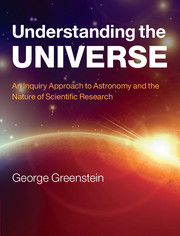Book contents
- Frontmatter
- Contents
- Preface
- Acknowledgments
- Part I Introducing steps to astronomy
- Part II The Solar System
- Part III Introducing stars
- 11 Our Sun
- 12 A census of stars
- 13 The formation of stars and planets
- 14 Stellar structure
- 15 Stellar evolution and death
- Part IV Introducing galaxies and the Universe
- Epilog
- Appendix I The small-angle formula
- Appendix II Exponential notation
- Appendix III The Solar System
- Appendix IV The closest and brightest stars
- Appendix V Physical and astronomical constants
- Appendix VI Conversion factors
- Appendix VII Constellation maps
- Glossary
- Figure Credits
- Index
- Plate section
15 - Stellar evolution and death
from Part III - Introducing stars
Published online by Cambridge University Press: 05 February 2013
- Frontmatter
- Contents
- Preface
- Acknowledgments
- Part I Introducing steps to astronomy
- Part II The Solar System
- Part III Introducing stars
- 11 Our Sun
- 12 A census of stars
- 13 The formation of stars and planets
- 14 Stellar structure
- 15 Stellar evolution and death
- Part IV Introducing galaxies and the Universe
- Epilog
- Appendix I The small-angle formula
- Appendix II Exponential notation
- Appendix III The Solar System
- Appendix IV The closest and brightest stars
- Appendix V Physical and astronomical constants
- Appendix VI Conversion factors
- Appendix VII Constellation maps
- Glossary
- Figure Credits
- Index
- Plate section
Summary
We closed Chapter 12 on the “census of stars” with a question: what is the significance of the three categories of stars: main sequence, red giant and white dwarf? In Chapter 14 we reached an understanding of main sequence stars: they are powered by thermonuclear reactions that transform hydrogen into helium. In this chapter we move on to red giants and white dwarfs.
We can think of the hydrogen in a main sequence star as fuel that powers its shining. In the previous chapter we explained that a star has lots of hydrogen, so that it can continue shining for a long time. But no matter how long this can go on, eventually the star will run out of this fuel. You might think that, once this happens, the star will simply go out. But it turns out that helium, the residue of hydrogen reactions, is itself a fuel. In order to use this new fuel, the star must readjust its structure to become a red giant. Indeed, the subsequent evolution of a star is governed by a whole series of other such readjustments.
But this process cannot go on forever. Eventually, no more fuel will be left to the star. Again, you might think that, once this happens, the star will simply “die.” But it does not die. Instead, the star is utterly reborn as a new and exciting “corpse” – a white dwarf, a neutron star, a black hole or a cataclysmic supernova.
- Type
- Chapter
- Information
- Understanding the UniverseAn Inquiry Approach to Astronomy and the Nature of Scientific Research, pp. 414 - 448Publisher: Cambridge University PressPrint publication year: 2013



